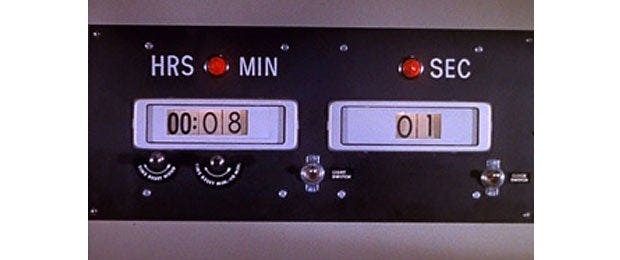Published Dec 17, 2010
Star Trek 365 -- Post Game Wrap Up!
Star Trek 365 -- Post Game Wrap Up!

If you read our StarTrek.com blog in September, you’ll recall that we’d just released a weighty tome called Star Trek The Original Series 365 for Abrams Books. And if you wonder, “What does a Star Trek author experience after the book comes out?” this post is for you!
The first thing(s) an author hopes to experience is “good reviews,” which may lead to bigger sales and, possibly, attention from the “mainstream” press. “ST 365” is our sixth Star Trek behind-the-scenes book, but none of the previous titles have been reviewed outside of Star Trek-dedicated fan sites and magazines. Not that we’re complaining—we’re as Star Trek-dedicated as they come—but we’ve always dreamed of being interviewed on, oh, you know, Charlie Rose, The Daily Show, The Colbert Report, Larry King... But you don’t see many (okay—any) Star Trek authors there. Sure enough, this time around you didn’t see us on any of those shows yet again. However, we did get to do a couple of sci-fi radio shows, and they were fun. Not exactly photo op experiences; they were phoners, so we didn’t even have to get out of our bathrobes. But on one show we co-starred with Nicholas Meyer (who was promoting his new autobiography The View From the Bridge). Very cool! We didn’t see him, of course, so we can’t report whether he, too, was in his bathrobe.
Beyond that, most of the hubbub emanated from the Internet, home to many of the good things and bad things in life. First up—the good: our hopes came to pass.
ST 365 drew countless digital reviews. A lot of them, predictably, came from sci-fi and comic book sites, by great bloggers (and friends, we’ll admit) like Bob Greenberger, Dayton Ward, Ian McLean, and Kevin Dilmore. But we also received notices from places like the Dallas Morning News, the Asbury Park (New Jersey) Press and Express Milwaukee. Miraculously, all of them were upbeat and positive (if occasionally a little condescending towards “Trekkies”). And we were ecstatic when two different reviewers crowed about the book on the Los Angeles Times' website (read here and here) —and then followed that up by asking us to participate in a digital Q&A session (read here).
In the following days, rave reviews popped up on the Underwire blog of Wired Magazine, the Holy Grail for geeks and large-lobed scientific types, and on Reuters.com, from Reuters News Service, which has been in business since l850 and today provides news reports to media around the world (read here). We also made several Christmas gift book lists, including (be still our hearts!) “National Public Radio’s Best Gift Books 2010” list (read here)—and we secured a lovely niche in the Smithsonian Institute’s beautiful Christmas catalogue, on the same page as the real-life space travel books by heroes like Buzz Aldrin.
And demonstrating that Star Trek truly does promote infinite diversity in infinite combinations, may we note the online kudos we got from Boston Edge (a regional news and entertainment site for the gay community) and Laura’s Playground, a forum for transgenders, transsexuals and crossdressers.
Now, you may recall that a few paragraphs ago we said, “First up—the good”? Well, it only follows that there’d be a “Next up—the bad.”
Amazon.com is where the readers who care the most about the subject matter can voice their opinions. We’re not Amazon virgins; we know that we’re just as likely to be panned as lauded by readers who post there, and sometimes we even agree with the critics (how did we miss that iota of trivia??) Amazon.com is also the place where writers can monitor their books’ popularity amidst the eight million titles the website tracks. Our book rose into the top one thousand after Amazon began shipping and rose steadily in the ranks to #160. We were very excited—could it be that this book would break through to the highly vaunted Top 100 bestsellers at Amazon???
The answer is…no. As Adrian Monk would say, “Here’s what happened…”
Those of you who’ve seen this book know that the page/spread numbers are “different.” They float half on and half off the page. The designer’s goal was to suggest the old-fashioned analog number readouts that graced Sulu’s panel on the original U.S.S. Enterprise. You know, where a little wheel mechanically rotated the numbers so that much of the time only a portion of the number was visible as it rolled over to the next number. That 20th century tech became obsolete very quickly. The designer adapted this endearingly retro detail in tribute to the art design of the series. Our editor liked it, and so did we. But a few readers didn’t get it. They returned the book to Amazon, noting an “obvious printing error.” Obviously, those readers didn’t understand infinite diversity in book design. Nevertheless, the folks at Amazon dutifully pulled the book from sales to study the “problem.” Four days later, they put the book back on sale. Unfortunately, during those days of limbo, it dropped from #160 to #17,636. It rose rather quickly again, prompted by the approaching Christmas season, but sadly, it never again topped the 500’s.
In any event, this “controversy” didn’t really affect book sales elsewhere. Abrams Books very quickly issued a second printing—and then a third. So happy ending after all.
And that’s what these particular Star Trek authors went through after the book came out. Along with walking the dogs, washing dishes, and sampling offerings from the latest television season.
We want to thank you all for your support over the years. We write these things for you (well, and a bit for ourselves). And you’ve been nice to us.
Merry Christmas.
